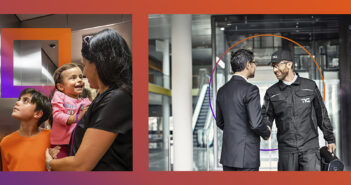With the advent of new technology, buildings are becoming increasingly intelligent, with smart buildings becoming more prevalent –yet this is only the beginning.
Businesses are demanding more from their buildings. No longer is it enough to simply house occupiers in standard office space, instead, they are requiring more technologically advanced set-ups to support their needs. As such, landlords and developers are becoming attuned to the fact that increased insight from data provided by smart technology can help shape their business strategy.
This shift to a data-led approach to real estate is permeating every facet of the built environment, often starting in the planning phase, through to architecture and design, development, documentation and property management – not to mention the sale and leasing cycles.
Smart buildings are a key element in the future of the real estate, the physical output of the shift occurring in the sector. Smart buildings are essentially an ecosystem within a physical asset, underpinned by connectivity, whereby different technologies can ‘talk’ to each other in order to respond to various needs, whether this is control of heating and ventilation, building access, staff utilisation or the understanding of portfolio assets. It is a culmination of the internet of things, which then provides data that can be aggregated and analysed to the benefit of investors, owners, landlords or businesses.
However, technology is not static. Its development is progressing rapidly as new innovations are being created. Buildings and the property industry must be able to respond to this or risk becoming obsolete. Therefore, as smart buildings evolve it is important to be in tune with how they are supporting the asset or occupier base, in order to determine where new innovations might be needed and to manage business pain points. By properly utilising the data drawn down from smart technologies property companies can anticipate the needs both of their customers and their buildings, keeping their businesses at the forefront of the industry.
Furthermore, smart building technology is not just a tool for new developments but can be inbuilt into existing assets in order to optimise a building’s performance. Retrofitting a building is not an easy task, so inputting the correct digital infrastructure and providing clear and accurate documentation is of paramount importance.
So how do we become smart?
As the tech giants of the world address, the balance between innovation, ease of use and scalability, thousands of brilliant ideas and ‘innovations’ are created on a regular basis.
However, it is important to discern whether new tech concepts are scalable and not just a fad so that businesses can determine how relevant an idea is when it becomes available to industries at large.
Central to this is understanding your customer base and as a fast-growth tech company, this is something we address every day at Matterport. Real estate is a passion of mine having begun my career as a surveyor at Cushman & Wakefield, so I can understand the inherent needs from both sides – both the tech as a product and the end-user – our customers. This balance is something we keep at the heart of our business.
As both the real estate industry and its customers intensify their calls for smarter buildings, we have found that 3D models can create a powerful digital system of record for any physical asset. Matterport technology has the ability to create a digital twin of a building, which can provide valuable documentation of properties, accurate to the centimetre. One day we hope to have a digital twin of every building in the built environment. This can support the rapidly evolving technologies being integrated into buildings – which can change the fabric of a physical asset – by helping to undertake maintenance, repairs and remodels with ease, or understanding how people interact with space.
As 3D technologies like Matterport become more advanced they will start to incorporate the human element. By incorporating humanity into 3D experiences, we will be able to better understand human interactions with buildings, and therefore, recognise how buildings can be further adapted for the future. Technology is ultimately here to address and aid human needs, so it’s crucial to understand what those are, so that we can learn how to respond.
The initial response has been incredible as we have seen the creation of incredible sensor technology, community engagement tools, access technology such as facial recognition software, as well as full physical developments. You need only look at the plans for Sidewalk Toronto to see how smart buildings and cities are driving the agenda not only in physical buildings in urban planning.
What’s more fascinating is that we are currently limited by our imagination – as our data sets evolve and our understanding of the impact of technology increases we will be able to dream bigger and therefore expand our innovative horizons.
At Matterport we are constantly innovating but with a core focus on our customer. Our aim as a business is to support the real estate industry as it becomes smarter. We want to create an ecosystem in partnership with developers and technology companies to allow Matterport and its 3D models to become integrated into the 3D workflows. Whether this is construction documentation, CAD, facilities management or even property management systems, they can all benefit from working with a true 3D representation, which is dimensionally accurate, of any building that they own, manage or occupy. This open architecture is going to accelerate innovation on top of our already widely distributed models. We’re going enhance them with partnerships with technology and real estate worlds.
Innovation in smart technologies is becoming more prevalent as occupiers move to a more flexible way of working. Flexible workspaces have become a huge trend in real estate, one that has been driven by occupiers’ needs as the way people work changes. This has been supported and will be enhanced by smart buildings.
The ability to understand how people use space and why they use it, especially as work habits change will not only allow developers and landlords to curate offices that people want to be in, but it will also allow agents to better market these workspaces by understanding their audiences, Beyond that, it may allow them to limit void time allowing landlords to stress their assets in order to increase ROI. Essentially, smart buildings when designed properly with the end-user, the tenant, in mind, will create value throughout all facets of a building’s life cycle.
Smart buildings will also have a huge impact on sustainability which is becoming an important issue for the real estate industry as the world faces an environmental crisis. Building operations is a huge contributor to the carbon footprint. In fact, the recently published report by the UK Green Building Council (UKGBC) shows that UK buildings account for around 30% of the UK’s carbon emissions. As a result, technologies focused on more efficient and intelligent building operations will be crucial in helping minimise waste inefficiencies and help create more sustainable cities for the future.
In order to achieve this, it will require collaboration between various areas of tech expertise such as IoT sensors, BIM, and imaging and augmented reality solutions, as well as geospatial mapping. By creating new innovations in this area, the industry can address waste management, building inefficiencies, remote inspections, resourcing on maintenance and repairs and greater building efficiency.
Building a digital twin for every building in the built environment increases learnings exponentially. So can we take it beyond one building to the entire fabric of the built environment? If buildings could learn to talk to each other this could play a vital role in supporting the growth of smart cities.



